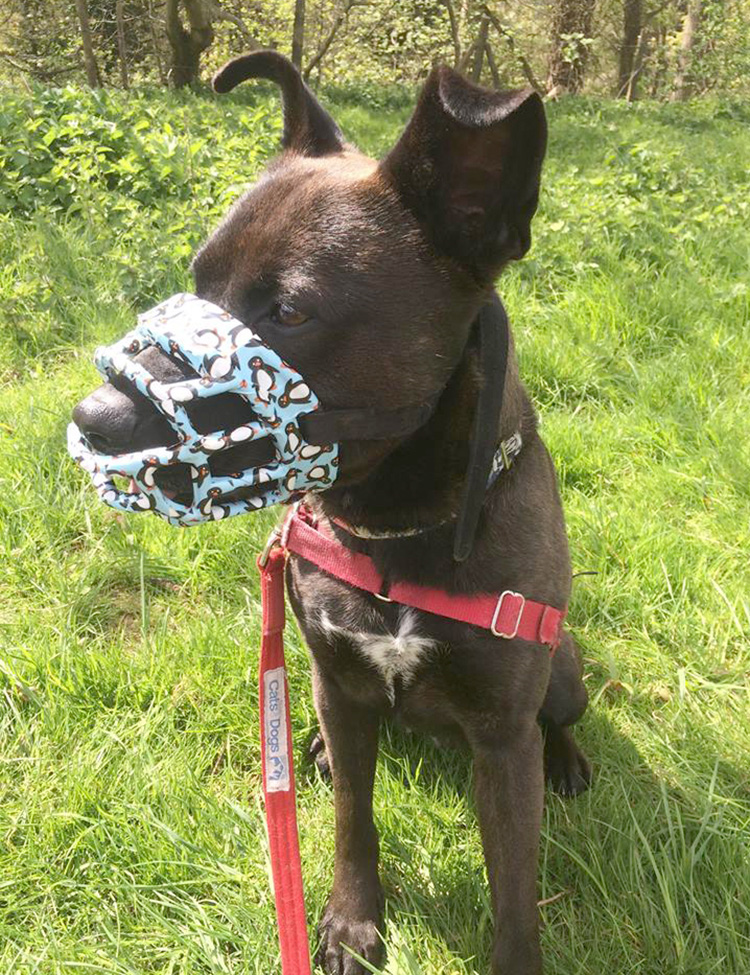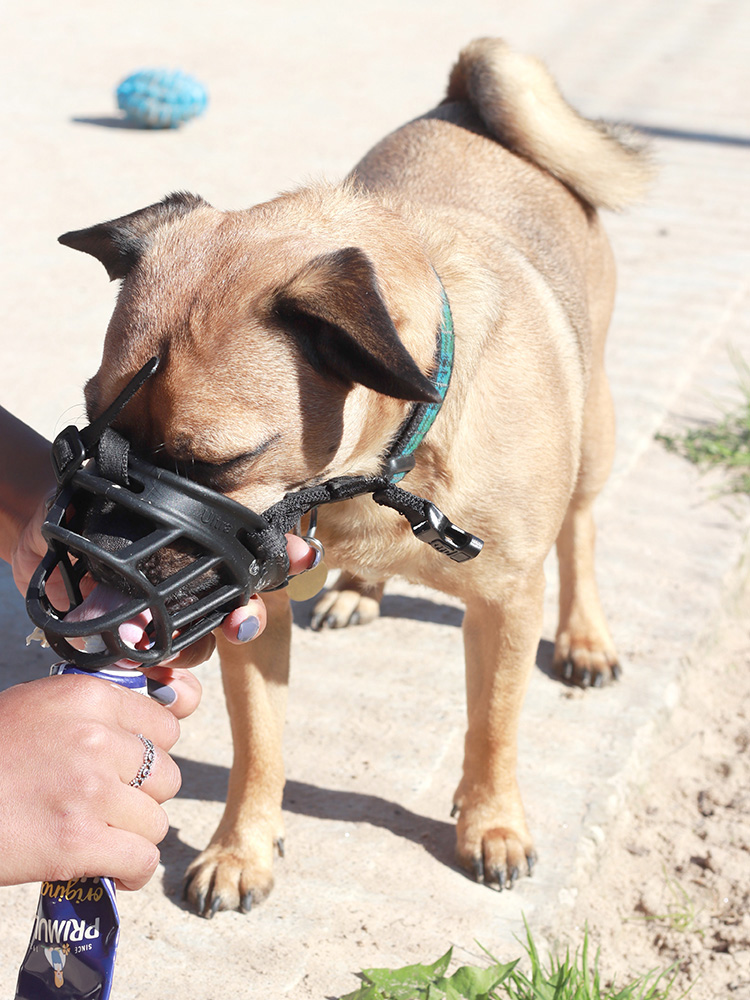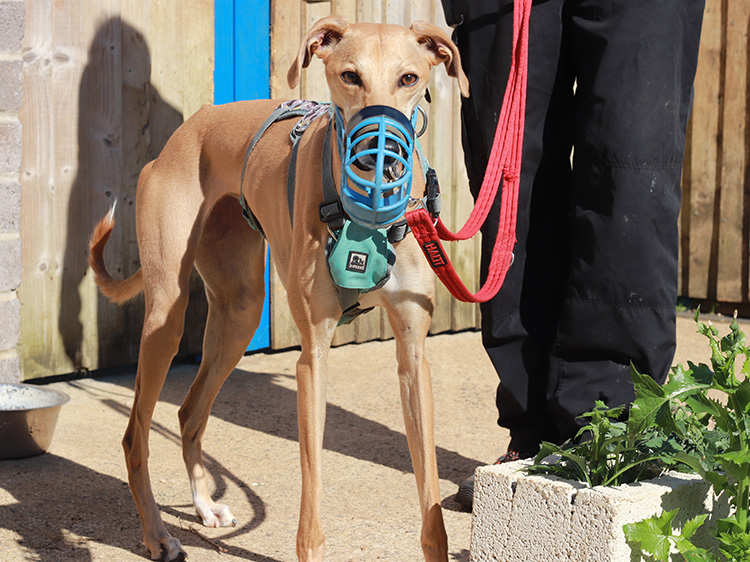Muzzles are a good thing, keeping your dog safe and keeping you relaxed. They may be daunting to some people due to their appearance, but it shows that you're a responsible dog owner, putting your dog's safety and wellbeing first.
» Jump to How to train your dog to wear a muzzle
A dog may need to wear a muzzle for several different reasons. They may be:
- A risk towards other dogs, cats, livestock or wildlife
- A risk towards strangers or meeting new people
- A risk towards veterinary staff or groomers who are formally handling them
- Excitably mouthing or grabbing on walks
- Compulsively eating harmful objects
From a legal perspective, there are serious implications for both dog and owner if incidents occur where there was a known history of aggression.

How to pick a good muzzle
- Make sure the muzzle fits well. Your dog should be able to pant, drink and eat treats posted into the muzzle.
- Do not use fabric muzzles as they do not allow a dog to properly pant. They are only for safety during short procedures at a vets.
- Opt for the plastic basket, box or Baskerville muzzles, you can customise them with bright washi tape to make them look more friendly, like the fun penguin tape above.
- There are specialist lurcher, whippet and greyhound muzzles which have a longer basket for those longer noses. They can be bought in all sorts of colours.
- A pad or strap across the bridge will help stop any rubbing. If you see any hair loss where the muzzle meets your dog's nose then the fit or material needs adjusting.
- For a bespoke fit, BUMAS muzzles are handmade to order, you can customise where the strap placements are, and choose from a wide range of colours. » Go to the BUMAS website
You cannot just place a muzzle onto a dog, do the training to prepare your dog for wearing a muzzle so that they are happy and stress-free to wear it.
How to train your dog to wear a muzzle
Each dog will have a different method of muzzle training that they are most responsive to - the main goal is that your dog is comfortable with each stage of training. If steps are missed or the dog is forced to wear the muzzle when it's not ready, the training will end up back at square one. Muzzle training can take a few weeks for some dogs, but others may take longer.
Never leave a dog unattended with a muzzle on.
Here are our two favourite training methods we use in the Home.
Method 1: Positive association for wearing a muzzle
- Start with the muzzle behind your back, bring it out, show it to your dog, say 'yes' and give a treat. Repeat over several sessions until your dog is excited to see the muzzle.
- Pop some really tasty treats inside the muzzle, or we love to smear some squeezy cheese in, and let your dog take their time in eating. Until your dog is relaxed and showing positive body language at this stage do not move onto the next step.
- You can gradually get your dog used to moving one strap at a time when they are busy eating the treats - this gets your dog used to the feel of the straps.
- Next stage is to hold the straps at the back of your dogs head, and release. Ensure your dog is relaxed eating treats in the muzzle. If your dog backs away then you are not ready for this stage. If you are struggling at this stage, do some gentle touching of the dog's head without the muzzle present, and always reward your dog for being calm.
- You can now get your dog used to having the muzzle fastened and unfastened. Your dog can now wear the muzzle for a few seconds at a time with you posting tasty treats in the sides of the muzzle. Gradually build up the time your dog is wearing the muzzle.

Method 2: Target training for wearing a muzzle
Some dogs respond better to target training than the positive association method as it enables them to think for themselves. Plus teaching a 'touch' is a useful trick to move your dog about.
- Hold a treat under your thumb with your palm facing your dog – when your dog touches your hand with his nose, say 'yes' and release the treat. Repeat in several training sessions, you can then offer your hand without the treat and when your dog touches it, say 'yes' and give them a treat.
- Once your dog is coming forward to touch your hand each time you produce it you can start adding the word 'touch' as you hold your hand out. Over time your dog will learn that this words means to touch your hand with their nose – this may take time as dogs pick up hand signals much quicker than words.
- Build up the length of time your dog is holding their nose to your hand e.g. holding it for one second, two seconds, before hearing 'yes' and getting the treat. This can be a tricky phase, consult a behaviour professional if you are having difficulties.
- You can then hold the muzzle with the opening facing towards your dog -you can say touch and hold your open palm over the enclosed bit of the muzzle in the exact same way as if you were practicing your 'touch', so your dog is encouraged to put their nose in the muzzle to touch your hand. Say 'yes' and reward as normal.
- Build up the amount of time your dog holds its nose in the muzzle by following the same procedure for duration that you did with your hand target. Gradually get them used to the straps moving while holding their nose in the muzzle, and having the muzzle on for short periods. This training will take time, and shouldn't be rushed.
- The next step is to add movement. Hold the muzzle away from your dog and they will take a few steps forward to 'touch' through the muzzle. You can gradually add more distance. Once your dog is then happy wearing the muzzle, you can use your touch to encourage them to walk with it on.
Top tip: Do muzzle training in various indoor and outdoor locations at every stage to prepare your dog for all situations.


